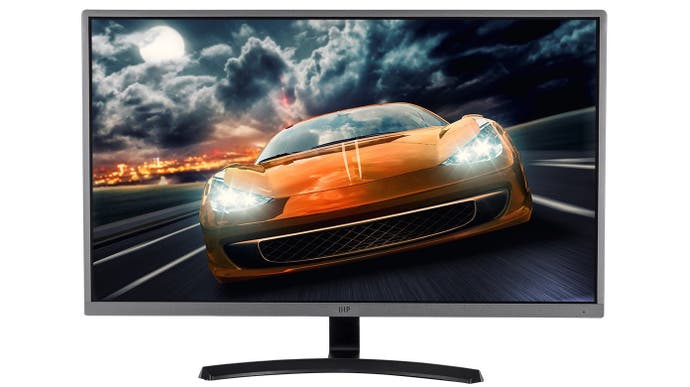Best FreeSync and 'G-Sync compatible' monitors for Nvidia graphics cards
Our pick of the best adaptive sync screens, covering a range of sizes and resolutions.
Hell froze over in early 2019 as Nvidia announced FreeSync support for GeForce graphics cards. There are 50 official G-Sync Compatible monitors as of October 2019 that have been tested and certified by Nvidia, but you're not limited to these models - any FreeSync or adaptive sync display that connects via DisplayPort can be used with recent Nvidia GPUs. It can be worth considering a FreeSync monitor too, as these don't require the expensive G-Sync module that pushes up the price of G-Sync monitors substantially - sometimes by hundreds of dollars compared to their FreeSync counterparts.
In this article, we'll show you exactly which FreeSync monitors we recommend, based on user testing and our own experience. We'll also try to answer your questions about how this all works in the first place with our guide to using FreeSync monitors with Nvidia graphics cards.
We'll be giving several recommendations over a range of price points, so you can find a monitor that suits your needs and budget. Each pick will support G-Sync on Nvidia graphics cards and FreeSync on AMD graphics cards, come with a wide enough variable refresh rate window and not exhibit problematic VRR behaviour like stuttering or strobing. We'll also mention which monitors support HDMI adaptive sync as this matters for anyone considering a FreeSync monitor to use with an Xbox One.
Note that this article is all about FreeSync monitors that work on Nvidia graphics cards. For monitors with native G-Sync support, please see our best gaming monitors article.
For now, let's get on with the picks!
Best 1080p 144Hz FreeSync monitor: ViewSonic XG2402
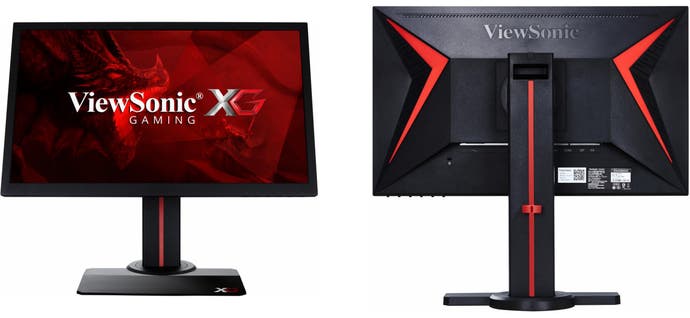
1920x1080 ● 144Hz ● 48-144Hz VRR range ● HDMI VRR Xbox One support
Buy from Amazon.com for $236 ● Buy from Amazon.co.uk for £229
The 24-inch ViewSonic XG2402 is an excellent choice for anyone that plays fast-paced games, thanks to its good VRR window of 48Hz to 144Hz, low input latency at 4ms and superior motion handling. This monitor is one of the few to include low frame-rate compensation (LFC), which prevents tearing when the frame-rate dips below the bottom of the VRR window. Surprisingly for a TN monitor, the out-of-the-box colour accuracy is good, but contrast and viewing angles remain disappointing - you'd need to consider a VA or IPS display if these are important features for you.
Best 1080p 240Hz FreeSync monitor: Samsung CRG5

1920x1080 ● 240Hz ● 48-240Hz VRR range
Buy from Amazon.com for $370 ● Buy from CCL Computers for £347
This curved 27-inch Samsung monitor is a strong choice for competitive gamers playing esports titles like Counter-Strike and Rainbow Six Siege, as even mid-range PCs can make full use of its 240Hz refresh rate. Happily, the CRG5's extremely high refresh rate is matched by its wide VRR window, ensuring tear-free images from 48 to 240Hz. The monitor also comes with some handy gaming features, such as the ability to brighten dark areas in games or overlay a better crosshair. Input lag is also low, as expected.
As this monitor uses a VA panel instead of the more common TN, it is able to hit an impressive 3000:1 contrast ratio and maintain good colour accuracy. However, this choice of panel technologies does have a downside, with a relatively high pixel response time of 4ms - we'd expect 1ms or lower from a 240Hz TN monitor. The stand provided is also very basic, with no height adjustment, but a 75x75 VESA mount can be used instead. Overall, the CRG5 offers reasonable value at its $400/£350 price point - just be aware of its limitations and take advantage of this monitor's strengths.
Best 1440p 144Hz FreeSync monitor: AOC AG271QX

2560x1440 ● 144Hz ● 30-144Hz VRR range ● HDMI VRR Xbox One support
Buy from Amazon.com for $390 ● Buy from Overclockers.co.uk for £420
The 27-inch Agon AG271QX combines a 1440p resolution with a 144Hz refresh rate, providing a noticeable improvement in two dimensions over standard 1080p60 monitors. The Agon's VRR range is one of the widest we've seen, extending from 30Hz to 144Hz to ensure that the technology will almost always be in play. That's particularly true on the Xbox One, as many titles dip into the thirties and most games don't offer graphical options. The TN panel used here offers extremely low input lag at 5ms, but does suffer from narrower viewing angles and poorer colour reproduction than VA or IPS displays. However, these are acceptable drawbacks for a gaming monitor at this price.
This monitor is also one of the best gaming monitors for the Xbox One, thanks to adaptive sync support over HDMI and a refresh rate of 120Hz. This works well in games like unlocked games like Rainbow Six Siege, and the higher refresh rate means an 8ms frame-time dip in games that run with v-sync enabled. 4K-capable titles on the Xbox One X also scale to 1440p with SSAA, providing an image that looks good at 27 inches.
Alternative: The cheaper 24-inch AG241QX offers similar VRR performance at $310/£320.
Best cheap 1440p FreeSync monitor: HP Pavilion 27q
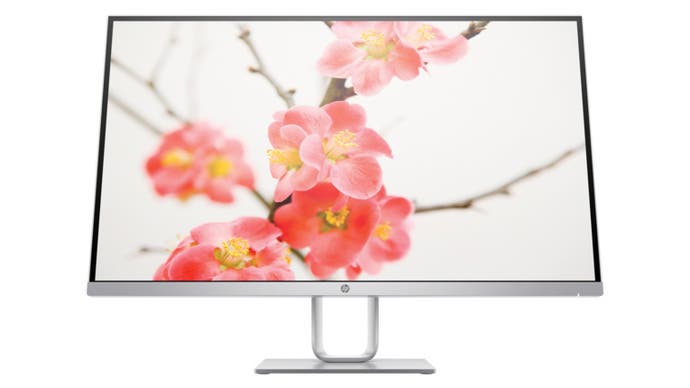
2560x1440 ● 75Hz ● 48-75Hz VRR range
Buy from HP.com for $279 ● Buy from HP.co.uk for £299
This 1440p IPS display works well with FreeSync on GeForce graphics cards, with a decent 48-75Hz VRR window and no visual artefacts or other issues. Given its relatively low refresh rate, its 8ms of input lag is quite competitive, allowing it to be a decent choice even for fast-paced games. The IPS panel provides an excellent image as well, with very good colour accuracy and decent viewing angles. Note that the monitor must be set to Gaming - FreeSync mode for it to be recognised as a G-Sync compatible display and for its 75Hz refresh rate to be activated.
Best ultra-wide FreeSync monitor: Samsung LC34J791
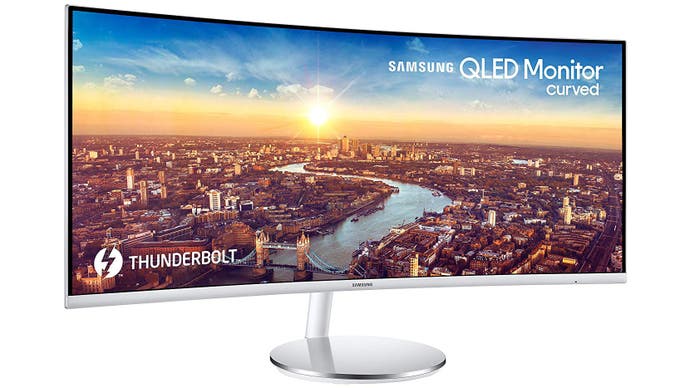
3440x1440 ● 100Hz ● 48-100Hz VRR range ● HDMI VRR Xbox One support
Buy from Amazon.co.uk for £721 ● Buy from Amazon.com for $799
This Samsung VA-panel monitor boasts excellent contrast, flawless 48-100Hz FreeSync support on Nvidia graphics cards and very low input lag of 6ms. That's a big improvement over the 23ms of input lag reported on its predecessor, the CF791, which also exhibited flickering with Nvidia graphics cards. The 3440 x 1440 resolution is impressive too, with enough detail to justify the 34-inch span but not enough to require an incredibly high-end PC. Finally, the C34J791 also includes Thunderbolt 3 USB-C, so you can connect a laptop to the monitor while charging it with a single cable. All in all, a convincing modern ultra-wide, and one of the few we've seen to play nicely with Nvidia graphics cards.
Best 4K FreeSync monitor: BenQ EW3270U
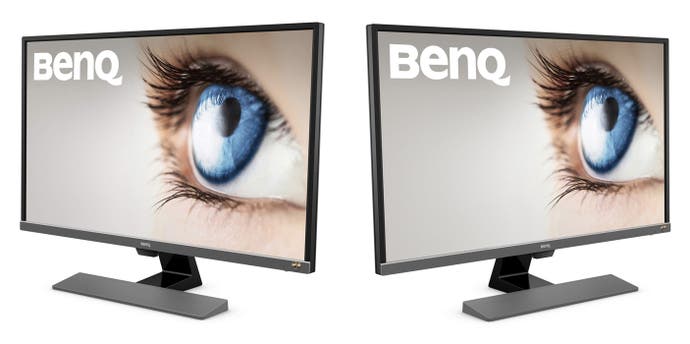
3840x2160 ● 60Hz ● 40-60Hz VRR range ● HDMI VRR Xbox One support
Buy from Amazon.co.uk for £390 ● Buy from Amazon.com for $523
This 32-inch 4K display by BenQ makes an excellent gaming monitor. It has a decent VRR window of 40 to 60Hz, exhibits no VRR issues with GeForce graphics cards and has low input lag for a 4K panel at just 9ms. The monitor also comes with HDR10 support, thanks to a high-quality VA panel that provides excellent contrast, good colours and decent viewing angles. The EW3270U supports FreeSync over both DisplayPort and HDMI, so Xbox owners get VRR too.
Best 4K FreeSync monitor (USA): Monoprice 27772
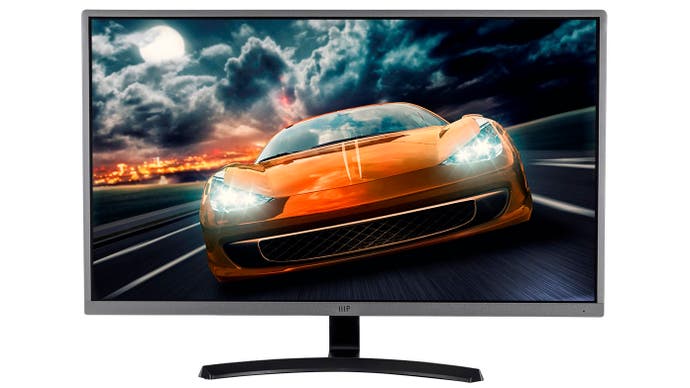
3840x2160 ● 60Hz ● 30-60Hz VRR range ● Buy from Monoprice.com for $320
This 32-inch IPS monitor from Monoprice offers exceptional quality for its price, including a wide FreeSync window of 30Hz to 60Hz. That makes it far easier to stay in the sweet spot for FreeSync gaming than monitors with minimum VRR range of 40Hz. The monitor's 10-bit panel provides good colour accuracy, decent contrast and excellent viewing angles too. It also supports the HDR10 standard on PCs, Xbox One and PS4. Sadly, the monitor does have its limitations as well, including no FreeSync over HDMI for Xbox users and little retail availability outside of the United States.
Best cheap 4K FreeSync monitor: Asus VP28UQG
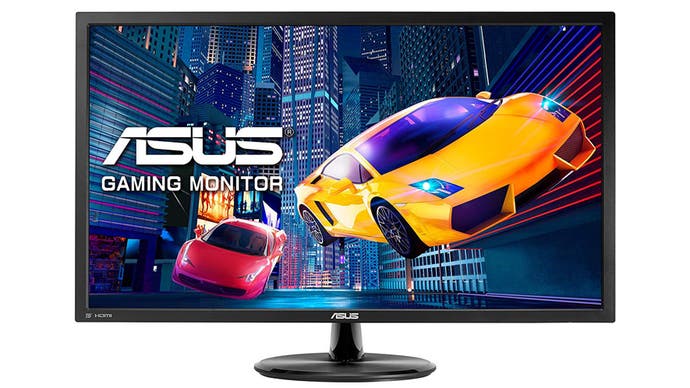
3840x2160 ● 60Hz ● 40-60Hz VRR range ● HDMI VRR Xbox One support
Buy from Amazon.co.uk for £258 ● Buy from Amazon.com for $312
This is one of the cheapest 4K FreeSync monitors on the market, and the test case of our recent Nvidia FreeSync investigation. It does exhibit occasional strobing when used in FreeSync mode, although this only occurs towards the bottom of its VRR window of 40 to 60Hz and on specific content. Otherwise, this monitor works well for FreeSync gaming on PC or Xbox. The VP28UQG uses a TN panel, which provides good response times but poorer colour accuracy and narrower viewing angles than you'd expect from VA or IPS displays. If your budget is limited but you still want a 4K FreeSync display, this is the best option we've found so far.
Best G-Sync Compatible 4K TV: LG C9 / E9

3840x2160 ● 120Hz ● 40-60Hz VRR range ● HDMI VRR Xbox One support
Buy from Amazon.co.uk for £1399 ● Buy from Amazon.com for $1496
If you're looking for a TV-sized G-Sync Compatible display, why not consider an actual TV? The LG C9 is one of the best TVs on the market right now, thanks to its OLED panel which provides extremely high contrast, excellent colour reproduction and strong motion handling too. The OLED panel also has very low input latency, making it an excellent choice for gaming on PC or consoles with game mode enabled. The C9 (and its bigger brother, the E9) are the first 4K TVs to be certified as G-Sync Compatible, and you're sure to have an incredible gaming (and movie watching) experience with one of these!
That's the end of our recommendations for now! Read on to learn how to set up your FreeSync monitor on a Nvidia graphics card, what makes a good FreeSync monitor and much more. You can also check out our best gaming monitors article to see a wider range of monitors than the ones we've considered here.
Guide to Nvidia FreeSync support
What is variable refresh rate, FreeSync and G-Sync?
Variable refresh rate (VRR) or adaptive sync technology is designed to eliminate ugly screen-tearing while reducing judder and lowering input lag compared to vanilla v-sync. VRR delivers smooth, consistent performance without having to lock to a specific frame-rate, achieved by synchronising your monitor's refresh with the output of your GPU, sometimes within a certain frame-rate range. Previously, Nvidia's support was limited to its own G-Sync displays, while AMD supported the open FreeSync standard. Since January 2019, owners of recent Nvidia graphics cards on the latest drivers can now enable G-Sync on FreeSync and other adaptive sync monitors.
What do you need to use G-Sync on a FreeSync monitor?
While Nvidia's new support for FreeSync and other adaptive sync monitors opens up many more options for owners of GeForce graphics cards, it does come with some limitations. Most importantly, only monitors connected via DisplayPort to a GeForce 10-series or 20-series graphics card are supported. That means that you can't connect to your FreeSync monitor using HDMI or DVI; similarly, you will not be able to use a FreeSync monitor with a GeForce 900-series graphics cards or older. Finally, you also need to install the 417.71 Nvidia driver (or later).
If your display is one of the 28 monitors that Nvidia have recognised as G-Sync compatible, all you need to do is connect the monitor and G-Sync will be automatically enabled. For other FreeSync monitors, you'll need to first enable FreeSync or adaptive sync in your monitor's on-screen display (OSD). Then, visit the Nvidia Control Panel, select 'Display', then 'Set up G-Sync'. Here, tick the box to enable G-Sync.
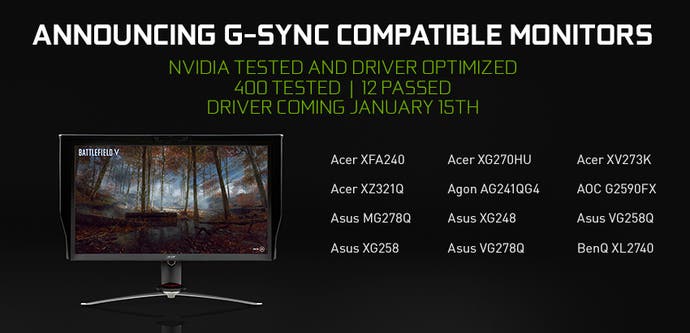
What makes a good FreeSync monitor?
There are many qualities that make up a good monitor, but the most important measurement for anyone looking to use G-Sync with a FreeSync display is the variable refresh rate window (or FreeSync window). This range tells you at what frame-rates FreeSync will actually be active. For example, a 40-60Hz window means that below 40fps and above 60fps, your monitor will exhibit judder and worse input latency if v-sync is enabled, or tearing if v-sync is disabled. That means if you're often dipping into thirty-something frames per second, you should turn down your in-game graphics settings until you're able to stay consistently within your window. A wider window makes it easier to stay within that window, providing more consistent variable refresh rate performance.
As well as having wider or narrower variable refresh rate windows, monitors can also exhibit other issues that may hamper your experience. Stuttering, flickering and other graphical artefacts have been reported on some monitors. These effects vary in their intensity and may even differ from unit to unit, so checking out user reports or sticking with Nvidia's recommended G-Sync Compatible models can help you to avoid problematic monitors. AMD's filterable FreeSync monitor database is also a good resource to keep in mind.
How to set up your PC for minimal input latency
In order to minimise the time between pressing 'fire' on your mouse and seeing the result on screen when using adaptive sync, it's important to run your games in native full-screen mode, rather than windowed or windowed full-screen. You also may wish to use an FPS limiter of some kind to improve performance. Some games include this in their settings (e.g. fps_max in CS:GO) and you can also use third-party tools such as RTSS to accomplish the same goal. If you set the maximum frame-rate to a few frames below your monitor's refresh rate, such as 138fps on a 144Hz monitor, you'll ensure that you get low input latency consistently, even if you turn on both G-Sync and V-Sync. Otherwise, exceeding the variable refresh rate range of the monitor will result in the input delay associated with standard v-sync if it is enabled, or tearing if it is not. This recent video by Battle(non)sense does well to explain this complicated topic. Another solid option is this older but still-relevant G-Sync 101 explainer from Blur Busters.
What's the difference between G-Sync and G-Sync Compatible?
G-Sync monitors are those that include G-Sync hardware modules inside. These push up the cost of a monitor, but allow for a full variable refresh rate range and are certified by Nvidia to pass various quality standards. G-Sync Compatible monitors may operate within more narrow variable refresh rate ranges and aren't tested as stringently, but have been certified by Nvidia to not exhibit issues like flicker, blanking and other visual artefacts while adaptive sync is enabled.
Here are the 28 G-Sync Compatible monitors that Nvidia currently recommend, including information on their size, HDR capabilities, resolution, panel type and FreeSync range.
| Model | HDR | Size | Panel | Resolution | VRR range |
|---|---|---|---|---|---|
| Acer CP3271K P | Yes | 32 | IPS | 3840x2160 | 48-120Hz |
| Acer CG437K P | Yes | 43 | VA | 3840x2160 | 48-120Hz |
| Acer ED273 Abidpx | No | 27 | VA | 1920x1080 | 48-144Hz |
| Acer KG271 Bbmiipx | No | 27 | TN | 1920x1080 | 48-240Hz |
| Acer VG252Q P | No | 25 | IPS | 1920x1080 | 48-144Hz |
| Acer XB273K GP | Yes | 27 | IPS | 3840x2160 | 48-120Hz |
| Acer XF240H Bmjdpr | No | 24 | TN | 1920x1080 | 48-144Hz |
| Acer XF250Q Cbmiiprx | No | 24.5 | TN | 1920x1080 | 48-240Hz |
| Acer XF270H BBMIIPRX | No | 27 | TN | 1920x1080 | 48-144Hz |
| Acer XFA240 | No | 24 | TN | 1920x1080 | 48-144Hz |
| Acer XG270HU | No | 27 | TN | 2560x1080 | 40-144Hz |
| Acer XV273K | Yes | 27 | IPS | 3840x2160 | 48-120Hz |
| Acer XV273 X | No | 27 | IPS | 1920x1080 | 48-240Hz |
| Acer XZ321Q | No | 32 | VA | 1920x1080 | 48-144Hz |
| AOC AG241QX | No | 24 | TN | 2560x1440 | 30-144Hz |
| AOC AG272FCX6 | No | 27 | VA | 1920x1080 | 48-165Hz |
| AOC AG272FG3R | No | 27 | VA | 1920x1080 | 48-165Hz |
| AOC G2590FX | No | 24.5 | TN | 1920x1080 | 30-146Hz |
| AOC G2590PX | No | 24.5 | TN | 1920x1080 | 30-144Hz |
| AOPEN 27HC1R Pbidpx | No | 27 | VA | 1920x1080 | 48-144Hz |
| Asus MG278Q | No | 27 | TN | 2560x1440 | 40-144Hz |
| Asus VG248QG | No | 24 | TN | 1920x1080 | 48-144Hz |
| Asus VG258Q | No | 24.5 | TN | 1920x1080 | 40-144Hz |
| Asus VG258QR | No | 24.5 | TN | 1920x1080 | 40-165Hz |
| Asus VG27AQ | Yes | 27 | IPS | 2560x1440 | 48-144Hz |
| Asus VG278Q | No | 27 | TN | 1920x1080 | 40-144Hz |
| Asus VG278QR | No | 27 | TN | 1920x1080 | 40-165Hz |
| Asus VG27A | Yes | 27 | IPS | 2560x1080 | 48-144Hz |
| Asus XG248Q | No | 23.8 | TN | 1920x1080 | 48-240Hz |
| Asus XG258Q | No | 24.5 | TN | 1920x1080 | 48-240Hz |
| BenQ XL2540 | No | 24.5 | TN | 1920x1080 | 48-240Hz |
| BenQ XL2740 | No | 27 | TN | 1920x1080 | 48-240Hz |
| Dell S2419HGF | No | 24 | TN | 1920x1080 | 48-120Hz |
| Gigabyte AD27QD | Yes | 27 | IPS | 2560x1440 | 48-144Hz |
| Gigabyte FI27Q | No | 27 | IPS | 2560x1440 | 48-144Hz |
| Gigabyte FI27Q-P | Yes | 27 | IPS | 2560x1440 | 48-165Hz |
| HP 24x | No | 24 | TN | 1920x1080 | 48-144Hz |
| HP 25mx | No | 25 | TN | 1920x1080 | 48-144Hz |
| HP 25x | No | 25 | TN | 1920x1080 | 48-144Hz |
| HP Omen X 25f | No | 25 | TN | 1920x1080 | 48-240Hz |
| LG 27GK750F-B | No | 27 | TN | 1920x1080 | 48-240Hz |
| LG 27GL63T | Yes | 27 | IPS | 1920x1080 | 48-144Hz |
| LG 27GL650 | Yes | 27 | IPS | 1920x1080 | 48-144Hz |
| LG 27GN750 | Yes | 27 | IPS | 1920x1080 | 48-240Hz |
| LG 27GL850 | No | 27 | IPS | 2540x1440 | 48-144Hz |
| LG 34GL750 | No | 34 | IPS | 2560x1080 | 50-144Hz |
| LG C9 | Yes | 55/65/77 | OLED | 3840x2160 | 40-120Hz |
| LG E9 | Yes | 55/65 | OLED | 3840x2160 | 40-120Hz |
| Razer Raptor 27 | No | 27 | VA | 1920x1080 | 48-240Hz |
| Samsung CRG5 | No | 27 | VA | 2560x1440 | 48-240Hz |
Other monitors can work with G-Sync even if they're not officially G-Sync Compatible, but they haven't been certified by Nvidia - so in these cases, we relied on user reports and our own testing to ensure performance is adequate for the monitors we've recommended above.
